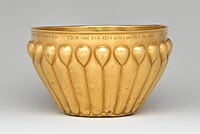
The Nanyue silver box (Ch: 南越裂瓣纹银器) is an ancient silver box with lobed decoration (裂瓣纹) discovered in Southern China in the tomb of Emperor Wen of Nanyue (who died in 124 BCE).
The object is now located in the Museum of the Mausoleum of the Nanyue King. It is thought to reflect the influence of Achaemenid art and Persian art and Persian metalware on Chinese culture. This design especially flourished under the Achaemenid Empire.
Many similar silver boxes have been excavated in Chinese archaeological site. Two similar boxes were excavated in 2004 in a tomb of the Warring States period (475-221 BCE) in Xixin (西辛), Qingzhou.
They were probably manufactured in Central China, rather than in Western Asia or Nanyue as initially thought, as they used Chinese casting technology rather than the cold-hammered technology generally used in Iran. The Nanyue Silver Box is considered as a case of luxurious artifact using a combination of foreign style, imported from West Asia and already influential in 3rd century BCE Han China, with Chinese manufacturing technology.
Western Asian examples
-
 Fluted bowl, Achaemenid, 6th-5th century BCE. Metropolitan Museum.
Fluted bowl, Achaemenid, 6th-5th century BCE. Metropolitan Museum.
-
 Iranian Shallow Vessel. Walters Museum
Iranian Shallow Vessel. Walters Museum
-
 Gadrooned bowl. Silver. West of Iran. 700-500 BCE. Louvre museum
Gadrooned bowl. Silver. West of Iran. 700-500 BCE. Louvre museum
References
- ^ Nickel, Lucas (2012). "Nanyue Silver Box". Arts of Asia. 42 (3): 98–107.
A silver box excavated from the tomb of Zhao Mao (late 2nd century BC), the King of the Nanyue state of the Western Han period, has become well known among scholars because of its obvious similarity to Iranian silverware since it was first discovered in 1983 (Rawson, 1999: 22e23). In light of recent archaeological finds of similar metal boxes in many different sites in China, Nickel (2012) proposed that the Nanyue silver box was produced most probably during the 3rd century BC, and it was not made in Western Asia or in Nanyue, but most likely in a Central China workshop. This view presents a sharp contrast with what it was previously believed.
- 李, 零 (2014). "On the Silver Multi-lobed Dou-Stemmed Bowl Unearthed from the Tomb of the WarringStates Period at Xixin——Also on the Similar Artifacts Unearthed in China - CNKI" (PDF). 文物. 9.
裂瓣纹金银器,鼎盛时期是阿契美尼德王朝
- 李, 零 (2014). "On the Silver Multi-lobed Dou-Stemmed Bowl Unearthed from the Tomb of the WarringStates Period at Xixin——Also on the Similar Artifacts Unearthed in China - CNKI" (PDF). 文物. 9.
西辛战国墓是2004年的重大考古发现,其出土物中有两件裂瓣纹银器
- ^ Guan, Liu; Bing, Huang (2023). "The hybrid origin of the dragon-wrapped column in Han dynasty China". Journal of Asian Architecture and Building Engineering. 22 (4): 1970–1994. doi:10.1080/13467581.2022.2153057. S2CID 256778140.
Other evidence for the column's origin as a result of the Maritime Silk Road is Lukas Nickel's article in 2012 discussing a foreign-looking, lobed-pattern silver box apparently borrowed from Iranian silverware excavated from the tomb of the Nanyue 南越 King in Guangzhou (mid-Western Han dynasty) (Figure 34) in the second century BCE. The ornament (two bands of tear-shaped lobes facing in alternate directions) has no Chinese precedents but was popular in contemporary Central and Western Asia as well as in the Eastern Mediterranean. Based on residual metal holes on the body of the Nanyue silver box, proof that it was created using Chinese casting technology rather than the cold-hammered technology of Iran, Nickel deduced that this artifact was a combination of foreign style and Chinese technology, and that the silver box was made in China rather than imported. The case of the silver box reveals that Han China may have purposefully adopted a Western Asian pattern, demonstrating that the Chinese were already aware of civilization beyond the Pamir Mountains in the third century BCE.
- "Fluted bowl Achaemenid". The Metropolitan Museum of Art.